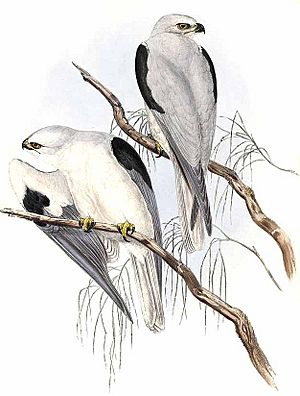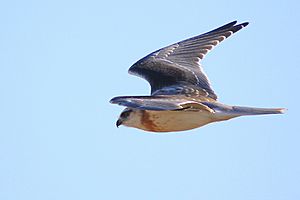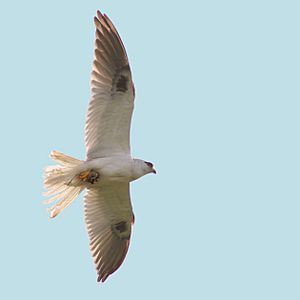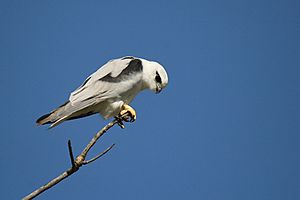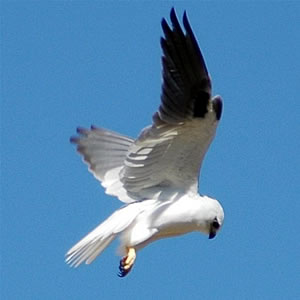Black-shouldered kite facts for kids
Quick facts for kids Black-shouldered kite |
|
|---|---|
 |
|
| At Royal Botanic Gardens, Cranbourne, Melbourne, Victoria, Australia | |
| Conservation status | |
| Scientific classification | |
| Genus: |
Elanus
|
| Species: |
axillaris
|
 |
|
| Range of black-shouldered kite | |
The black-shouldered kite (Elanus axillaris), also called the Australian black-shouldered kite, is a small raptor found in open areas across Australia. It looks a lot like similar birds in Africa, Europe, Asia, and North America.
This bird is about 35 cm (14 in) long with a wingspan of 80 to 100 cm (31 to 39 in). Adult kites are mostly grey and white. They have bright red eyes with black marks above them. Their name comes from the black patches on their wings, which look like "shoulders." Their main call is a clear whistle. They can be confused with the letter-winged kite in Australia, but that bird has black marks under its wings.
Black-shouldered kites form pairs and breed between August and January. They perform special aerial dances to find a mate. They lay three or four eggs, which hatch in about 30 days. Young birds can fly within five weeks and hunt mice a week after leaving the nest. These kites hunt in open grasslands. They look for prey by hovering in the air and scanning the ground. They mainly eat small rodents, especially the house mouse. Farming has actually helped them by creating more places for mice to live. The black-shouldered kite is listed as "Least Concern" by the International Union for Conservation of Nature (IUCN). This means it is not currently in danger of disappearing.
Contents
About the Black-shouldered Kite's Name
The black-shouldered kite was first described by an English bird expert named John Latham in 1801. He called it Falco axillaris. The name axillaris comes from a Latin word meaning "armpit." This refers to the dark patches under the bird's wings. Latham's description came from a bird seen in the early days of the Sydney colony.
Another English naturalist, John Gould, later described the same bird in 1838. He called it Elanus notatus. However, Latham's name was older, so it was used instead. For many years, there was some confusion about which name was correct. But in 1980, Australian experts confirmed that Latham's original name, Elanus axillaris, was the right one. This bird is considered a single species, meaning there are no different types or subspecies.
The International Ornithologists' Union (IOC) officially calls it the "Black-shouldered kite." It's also known as the "Australian black-shouldered kite" to tell it apart from similar birds. These include the black-winged kite from Europe/Asia and the white-tailed kite from America. Both of these were once also called "black-shouldered kite."
Scientists have studied the black-shouldered kite and its relatives. They found that these birds belong to a special group called Elaninae. This group is an early branch within the Accipitridae family, which includes many birds of prey. Some scientists even think they might be different enough to be in their own family.
What the Black-shouldered Kite Looks Like
An adult black-shouldered kite is about 35 cm (14 in) long. Its wingspan is between 80 and 100 cm (31 and 39 in). Females are a bit heavier, weighing about 300 grams (10.6 oz), while males weigh around 260 grams (9.2 oz). Both male and female birds look similar.
Their head and belly are white, and their back and neck are pale grey. They have a black, comma-shaped mark in front of and around their deep red eyes. The front edge of their outer wing is black. When the bird is sitting, these black parts look like prominent "shoulders," which gives the bird its name. Their tail feathers are white, except for the middle ones, which are pale grey. Their beak is short and hooked, with a black tip. Their nostrils and the waxy part above the beak (called the cere) are bright yellow. Their legs and feet are also yellow.
Young black-shouldered kites look a bit different. They have a white forehead and chin. Their neck, back of the head, and chest are rusty brown with darker stripes. Their back and wings have mottled buff or brown patches. Their black shoulder patch is less clear, but the comma-shaped mark around their eyes is larger. Their eyes are dark brown, and their beak is black with a horn-colored cere.
When flying, black-shouldered kites often spiral into the wind, much like a kestrel. They soar with their wings curved upwards in a V-shape. Their wingtips are slightly spread, and their tail is fanned out. This makes their tail look squarer and their wingtips look like "fingers." They often hover in the air with their wings curved and tail pointing down.
This kite looks very similar to the letter-winged kite (E. scriptus). However, the black-shouldered kite has the black mark above and behind its eye. Its crown (top of the head) is white, not grey. In flight, its underside is all white, except for the black shoulder marks, dark wingtips, and a small black patch under the wing. It is slightly larger than the nankeen kestrel (Falco cenchroides). The kestrel has no wing markings and is pale brown. It also keeps its wings level when soaring and beats its wings faster when hovering.
Kite Calls
The black-shouldered kite is usually quiet. But during breeding season, its calls can be heard often, even if they are not very loud. It mainly makes a clear whistled chee, chee, chee sound when flying or hovering. When perched, it might make a hoarse, wheezing skree-ah sound. A short, high whistle is how pairs talk to each other. Females and older young often make a harsh scraping call. Females caring for young chicks might make a deep, soft, frog-like croak.
Where the Black-shouldered Kite Lives and Its Home
Black-shouldered kites can stay in one place or move around. They usually live in open grasslands or valleys with scattered trees. They like areas where the grass is not too tall (30 cm to 1.5 m or 1 to 5 ft) so they can easily see their prey from the air. They also hunt over farmlands, like pastures, cereal fields, or vineyards. They often look for food in areas that have just been harvested or plowed, as this makes prey easier to spot.
In towns, you might see them on the edges of cities, in empty lots, sports fields, golf courses, or grassy roadsides. They also hunt over coastal sand dunes and drier marshlands. However, they avoid thick forests or bare, rocky ground.
Their numbers can change a lot during droughts and floods. Their population can also suddenly increase when there are many mice, like during a mouse plague. One banded bird was found 1073 km (667 mi) away from where it was tagged, showing how far they can travel.
Even though they are found all over Australia, they are most common in the fertile southeastern and southwestern parts of the mainland, and in southeastern Queensland. They are rare in very dry desert areas. They sometimes visit northern Tasmania, King Island, and the Torres Strait islands.
How Black-shouldered Kites Behave
Black-shouldered kites usually hunt alone or in pairs. But if there's a lot of food, they might gather in small family groups. During mouse plagues, many birds can be seen feeding together, sometimes up to 70 at once. They also roost (sleep) together in groups. If food is scarce, they become more protective of their territory. When they land, they often flick their tail up and down. This "tail flicking" might be a way to show other birds that this area is their territory.
Breeding and Raising Young
When black-shouldered kites are looking for a mate, they perform special aerial displays. Both birds might fly high in circles. The male might fly around with his wings held high, fluttering them quickly. Courting males will dive at the female and feed her while they are both flying. The female grabs food from the male's talons with her own, sometimes flipping upside down. They might even lock talons and tumble downwards, but they let go before hitting the ground. All these courtship displays involve constant calling.
Black-shouldered kites form pairs that stay together. The breeding season is usually from August to January. However, if there are a lot of mice, they might breed twice in one good season. Both the male and female collect sticks for the nest, but only the female builds it. The nest is a large, messy, shallow cup made of thin twigs. It takes two to six weeks to build. It's usually about 28 to 38 cm (11 to 15 in) wide when new, but can grow to 78 cm (31 in) wide and 58 cm (23 in) deep after being used many times. The nest is lined with green leaves and soft fur. Sometimes, they use grass or cow dung as well. Nests are usually high up (5 to 20 m or 16 to 66 ft) in a tree in open country. Black-shouldered kites have also been known to use old nests built by Australian magpies, crows, or ravens.
The female bird does most of the work caring for the eggs and chicks. The male helps a little with sitting on the eggs and keeping the chicks warm. A clutch usually has three to four dull white eggs. They are oval-shaped, about 42 x 31 mm (1.7 x 1.2 in), and have red-brown spots, often more at the wider end. The eggs are laid every two to five days. The female sits on the eggs for 30 days. When the chicks hatch, they are helpless but covered in soft down. For the first two weeks, the female stays with the chicks constantly, day and night. She doesn't hunt at all for the first three weeks after the chicks hatch. Instead, she calls to the male from the nest, and he brings food. The female feeds the chicks the mice the male brings. She tears the mice into tiny pieces for the first week or two, after which the chicks can swallow a whole mouse.
The chicks stay in the nest for about 36 days. After they leave the nest, they are still fed by their parents for at least 36 more days. When the chicks are older, both parents take turns feeding them. Black feathers start to appear on the chicks' wings when they are about two weeks old. They are fully feathered and ready to fly in five weeks. Within a week of leaving the nest, the young birds can hunt for mice on their own. Young birds often travel far from their nest, sometimes as much as 1000 km (620 mi) away, to find their own territory.
What Black-shouldered Kites Eat and How They Hunt
The black-shouldered kite has become a special hunter of the introduced house mouse. They often appear in large numbers when there are mouse plagues in rural areas. They will also eat other small creatures if they can find them, like grasshoppers, rats, small reptiles, birds, and very rarely, even rabbits. But mice and other mouse-sized mammals make up over 90% of their diet. They likely help control mouse populations. Adult kites can eat two or three mice a day, which is about a thousand mice a year! Once, a male kite was seen bringing 14 mice to a nest of almost-grown chicks in just one hour. In another study, a female kite struggled to bring a three-quarters grown rabbit back to her chicks, which is a very heavy load for such a small bird.
Like other kites in their group, black-shouldered kites hunt by flying over grasslands looking for small creatures. They can hunt from a perch, but they more often hover in the air. They hunt during the day, especially in the early morning and late afternoon. Sometimes, they hunt in pairs. When not breeding or when food is not super abundant, they hunt most actively around dawn and dusk, which might be when mice are most active.
When hunting, the kite hovers with its body almost straight up and its head facing into the wind. Unlike the nankeen kestrel, the black-shouldered kite doesn't move sideways much, even in strong winds. One study found that a male kite spent 82% of its hunting time searching from the air. A kite typically hovers 10 to 12 meters (33 to 39 ft) above a spot, looking down carefully. It might do this for only a few seconds or for a minute or more. Then it glides quickly to a new spot and hovers again. When hunting from a perch, a dead tree is a favorite spot. Black-shouldered kites can grip a vertical branch with one foot above the other, turned inwards. This helps them hold on tightly to small branches. Even though hovering is their most common hunting method, they have been seen searching the ground from a perch for up to an hour.
When a mouse or other prey is spotted, the kite drops silently onto it, feet-first with wings raised high. Sometimes it's one long drop to the ground, but more often it's in two or more steps, with hovering stops in between. They grab their prey with their talons, and about 75% of their attacks are successful. They can eat their prey while flying or carry it back to a perch. Birds often have a favorite feeding perch, where you can find piles of pellets (undigested food) underneath.
Conservation Status
Human activities in Australia have generally helped the black-shouldered kite. Clearing land and using irrigation for farming, along with storing grain, create good conditions for many more mice. Since this bird has a large range and its population is growing, it is listed as "Least Concern" on the IUCN Red List of Threatened species. This means it is not currently at risk of extinction. In southwestern Australia, it has become one of the most common birds of prey in the wheat farming areas.
According to bird expert Stephen Debus, this species did not suffer from eggshell thinning when the pesticide DDT was used in Australia. However, he believes they could be poisoned if they eat rodents that have eaten rodenticides (mouse poison) or if they eat insects that have been sprayed with pesticides during locust plagues. In areas with many sheep and rabbits, the kite's population might decrease. This is because these animals compact the soil, which reduces the habitat available for mice.
See also
 In Spanish: Elanio australiano para niños
In Spanish: Elanio australiano para niños



